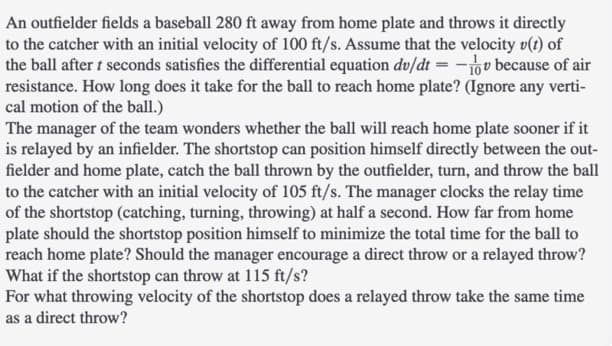An outfielder fields a baseball 280 ft away from home plate and throws it directly to the catcher with an initial velocity of 100 ft/s. Assume that the velocity v(t) of the ball after t seconds satisfies the differential equation dv/dt = -ov because of air resistance. How long does it take for the ball to reach home plate? (Ignore any verti- cal motion of the ball.) The manager of the team wonders whether the ball will reach home plate sooner if it is relayed by an infielder. The shortstop can position himself directly between the out- fielder and home plate, catch the ball thrown by the outfielder, turn, and throw the ball to the catcher with an initial velocity of 105 ft/s. The manager clocks the relay time of the shortstop (catching, turning, throwing) at half a second. How far from home plate should the shortstop position himself to minimize the total time for the ball to reach home plate? Should the manager encourage a direct throw or a relayed throw? What if the shortstop can throw at 115 ft/s? For what throwing velocity of the shortstop does a relayed throw take the same time as a direct throw?
An outfielder fields a baseball 280 ft away from home plate and throws it directly to the catcher with an initial velocity of 100 ft/s. Assume that the velocity v(t) of the ball after t seconds satisfies the differential equation dv/dt = -ov because of air resistance. How long does it take for the ball to reach home plate? (Ignore any verti- cal motion of the ball.) The manager of the team wonders whether the ball will reach home plate sooner if it is relayed by an infielder. The shortstop can position himself directly between the out- fielder and home plate, catch the ball thrown by the outfielder, turn, and throw the ball to the catcher with an initial velocity of 105 ft/s. The manager clocks the relay time of the shortstop (catching, turning, throwing) at half a second. How far from home plate should the shortstop position himself to minimize the total time for the ball to reach home plate? Should the manager encourage a direct throw or a relayed throw? What if the shortstop can throw at 115 ft/s? For what throwing velocity of the shortstop does a relayed throw take the same time as a direct throw?
Calculus: Early Transcendentals
8th Edition
ISBN:9781285741550
Author:James Stewart
Publisher:James Stewart
Chapter1: Functions And Models
Section: Chapter Questions
Problem 1RCC: (a) What is a function? What are its domain and range? (b) What is the graph of a function? (c) How...
Related questions
Question

Transcribed Image Text:An outfielder fields a baseball 280 ft away from home plate and throws it directly
to the catcher with an initial velocity of 100 ft/s. Assume that the velocity v(t) of
the ball after t seconds satisfies the differential equation dv/dt = -ov because of air
resistance. How long does it take for the ball to reach home plate? (Ignore any verti-
cal motion of the ball.)
The manager of the team wonders whether the ball will reach home plate sooner if it
is relayed by an infielder. The shortstop can position himself directly between the out-
fielder and home plate, catch the ball thrown by the outfielder, turn, and throw the ball
to the catcher with an initial velocity of 105 ft/s. The manager clocks the relay time
of the shortstop (catching, turning, throwing) at half a second. How far from home
plate should the shortstop position himself to minimize the total time for the ball to
reach home plate? Should the manager encourage a direct throw or a relayed throw?
What if the shortstop can throw at 115 ft/s?
For what throwing velocity of the shortstop does a relayed throw take the same time
as a direct throw?
Expert Solution
This question has been solved!
Explore an expertly crafted, step-by-step solution for a thorough understanding of key concepts.
This is a popular solution!
Trending now
This is a popular solution!
Step by step
Solved in 2 steps with 2 images

Knowledge Booster
Learn more about
Need a deep-dive on the concept behind this application? Look no further. Learn more about this topic, calculus and related others by exploring similar questions and additional content below.Recommended textbooks for you

Calculus: Early Transcendentals
Calculus
ISBN:
9781285741550
Author:
James Stewart
Publisher:
Cengage Learning

Thomas' Calculus (14th Edition)
Calculus
ISBN:
9780134438986
Author:
Joel R. Hass, Christopher E. Heil, Maurice D. Weir
Publisher:
PEARSON

Calculus: Early Transcendentals (3rd Edition)
Calculus
ISBN:
9780134763644
Author:
William L. Briggs, Lyle Cochran, Bernard Gillett, Eric Schulz
Publisher:
PEARSON

Calculus: Early Transcendentals
Calculus
ISBN:
9781285741550
Author:
James Stewart
Publisher:
Cengage Learning

Thomas' Calculus (14th Edition)
Calculus
ISBN:
9780134438986
Author:
Joel R. Hass, Christopher E. Heil, Maurice D. Weir
Publisher:
PEARSON

Calculus: Early Transcendentals (3rd Edition)
Calculus
ISBN:
9780134763644
Author:
William L. Briggs, Lyle Cochran, Bernard Gillett, Eric Schulz
Publisher:
PEARSON

Calculus: Early Transcendentals
Calculus
ISBN:
9781319050740
Author:
Jon Rogawski, Colin Adams, Robert Franzosa
Publisher:
W. H. Freeman


Calculus: Early Transcendental Functions
Calculus
ISBN:
9781337552516
Author:
Ron Larson, Bruce H. Edwards
Publisher:
Cengage Learning